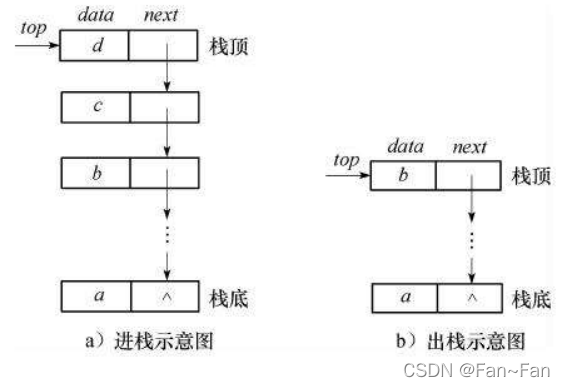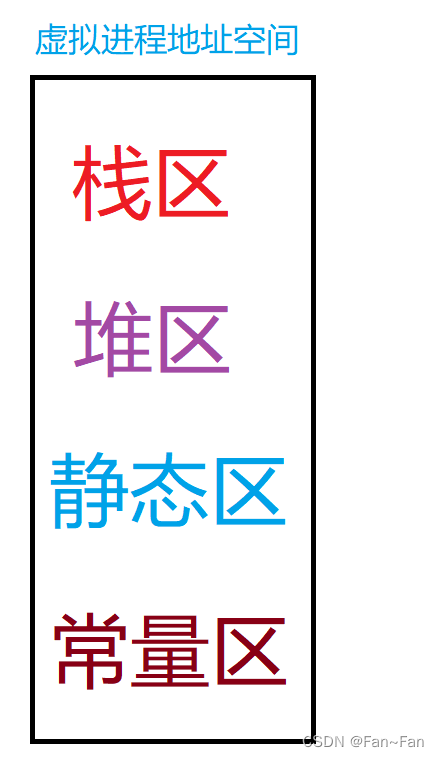数据结构“入门”—栈(C语言实现)
📭今天我们讲数据结构里面的栈,有了顺序表的基础后学习栈那真是唰唰唰的瞬间理解这些东西,非常的easy~~
1:栈的基本概念和结构
栈的概念📝
栈:一种特殊的线性表,其只允许在固定的一端进行插入和删除元素操作。进行数据插入和删除操作的一端称为栈顶,另一端称为栈底。栈中的数据元素遵守后进先出LIFO(Last In First Out)的原则。
压栈:栈的插入操作叫做进栈/压栈/入栈,(入数据在栈顶)
出栈:栈的删除操作叫做出栈。(出数据也在栈顶)
栈的结构📝
🤔函数的调用需要开辟栈,这两个栈是一回事吗?
函数调用开辟的栈是从内存中申请一块空间,属于虚拟进程地址空间,当程序运行起来执行函数时,函数栈帧用来存放局部变量、参数、返回值等等。和数据结构中的栈没有关联。这两个一个是数据结构中的栈,是一个数据结构。另一个是操作系统中内存划分的一个区域,叫做栈,用来函数调用时建立栈帧。
下面我们进入第二阶段

2:栈的实现
🖊:栈的实现一般可以使用数组或者链表实现,相对而言数组的结构实现更优一些。因为数组在尾上插入删除数据的代价比较小。

2-1:创建栈
Stack.h文件
//创建栈typedef int STDataType;typedef struct Stack{STDataType* a; //存储数据int top;//记录栈顶的位置int capacity; //记录栈的容量}ST;
2-2:初始化栈
思路:
初始化栈和顺序表的初始化大致相同。
Stack.h文件
//初始化栈void StackInit(ST* ps);Stack.c文件
//初始化栈void StackInit(ST* ps){assert(ps);ps->a = NULL;ps->top = 0;ps->capacity = 0;}
2-3:销毁栈
思路:
销毁栈和顺序表的销毁也大致一样,将开辟的数组空间free掉,把其余数据置为0.
Stack.h文件
//销毁栈void StackDestory(ST* ps);Stack.c文件
//销毁栈void StackDestory(ST* ps){assert(ps);free(ps->a);ps->a = NULL;ps->capacity = ps->top = 0;}
2-4:压栈
思路:
在我们要插入数据前,我们要判断栈的空间是否够用,如果top=capacity,则栈的空间已满,需要扩容,如果未满我们就压入数据,top++
Stack.h文件
//压栈(栈规定数据只能在栈顶插入,所以只有一种插入方式)void StackPush(ST* ps, STDataType x);Stack.c文件
//压栈(栈规定数据只能在栈顶插入,所以只有一种插入方式)void StackPush(ST* ps, STDataType x){assert(ps);//满了扩容if (ps->top == ps->capacity){int newCapacity = ps->capacity == 0 ? 4 : ps->capacity * 2; ps->a = (STDataType*)realloc(ps->a, newCapacity * sizeof(STDataType));if (ps->a == NULL){printf("realloc fail\n");exit(-1);}ps->capacity = newCapacity; //扩容}ps->a[ps->top] = x; //数据压栈(ps->top)++; //栈顶更新}
2-5:出栈
思路:
如果想要出栈,至少要保证栈中有元素,也就是pos->top>0,判断完如果符合条件,则和顺序表删除元素一样,将栈顶位置下移一位。
Stack.h文件
//出栈void StackPop(ST* ps);Stack.c文件
//出栈void StackPop(ST* ps){assert(ps);assert(ps->top > 0);//如果要出栈,至少要保证栈中有元素(ps->top)--;}
2-6:判断栈是否为空
思路:
判断栈是否为空只需判断top的值是否为0即可。
Stack.h文件
//判断栈中的数据是否为空bool StackEmpty(ST* ps);Stack.c文件
//判断栈中的数据是否为空bool StackEmpty(ST* ps){/*法一assert(ps);if (ps->top > 0){return false;}else{return true;}*///法二return ps->top == 0;}
2-7:访问栈顶元素
思路:
通过上文我们初始化top为0知道,当我们压栈时,是先把数据放进去然后top++;很明显栈顶的元素下标为top-1,所以我们访问栈顶元素就是访问数组所对应下标为top-1的元素。
Stack.h文件
//访问栈顶元素STDataType StackTop(ST* ps);Stack.c文件
//访问栈顶元素STDataType StackTop(ST* ps){assert(ps);assert(ps->top > 0);return ps->a[ps->top - 1];}
2-8:获取栈中有效元素个数
思路:
数组下标是从0开始的,我们要获取栈中有效元素个数即为top的值,所以我们直接返回top即可。
Stack.h文件
//获取栈中有效元素个数int StackSize(ST* ps);Stack.c文件
//获取栈中有效元素个数int StackSize(ST* ps){assert(ps);return ps->top;}
2-9:遍历打印栈
思路:
要遍历打印栈是要付出代价的,因为栈中的元素遵循后进先出,所以当栈不为空时打印栈顶元素,要访问下一个元素就把原先的栈顶元素删除,然后再次访问栈顶,直到栈中的元素为空。
Test.c文件
void TestStack(){ST st;StackInit(&st);StackPush(&st, 1);StackPush(&st, 2);StackPush(&st, 3);StackPush(&st, 4);while (!StackEmpty(&st)){printf("%d ", StackTop(&st));StackPop(&st);}printf("\n");StackDestory(&st);}int main(){TestStack();return 0;}
🚀 看了上面栈的实现是不是觉得很easy~~

3:总代码
Stack.h文件
#pragma once#include #include #include #include //创建栈typedef int STDataType;typedef struct Stack{STDataType* a; //存储数据int top;//记录栈顶的位置int capacity; //记录栈的容量}ST;//初始化栈void StackInit(ST* ps);//销毁栈void StackDestory(ST* ps);//压栈(栈规定只能在栈顶插入,所以只有一种插入方式)void StackPush(ST* ps, STDataType x);//出栈void StackPop(ST* ps);//判断栈中的数据是否为空bool StackEmpty(ST* ps);//访问栈顶元素STDataType StackTop(ST* ps);//获取栈中有效元素个数int StackSize(ST* ps);Stack.c文件
#include "Stack.h"//初始化栈void StackInit(ST* ps){assert(ps);ps->a = NULL;ps->top = 0;ps->capacity = 0;}//销毁栈void StackDestory(ST* ps){assert(ps);free(ps->a);ps->a = NULL;ps->capacity = ps->top = 0;}//压栈(栈规定数据只能在栈顶插入,所以只有一种插入方式)void StackPush(ST* ps, STDataType x){assert(ps);//满了扩容if (ps->top == ps->capacity){int newCapacity = ps->capacity == 0 ? 4 : ps->capacity * 2;ps->a = (STDataType*)realloc(ps->a, newCapacity * sizeof(STDataType));if (ps->a == NULL){printf("realloc fail\n");exit(-1);}ps->capacity = newCapacity; //扩容}ps->a[ps->top] = x; //数据压栈(ps->top)++; //栈顶更新}//出栈void StackPop(ST* ps){assert(ps);assert(ps->top > 0);//如果要出栈,至少要保证栈中有元素(ps->top)--;}//判断栈中的数据是否为空bool StackEmpty(ST* ps){/*法一assert(ps);if (ps->top > 0){return false;}else{return true;}*///法二return ps->top == 0;}//访问栈顶元素STDataType StackTop(ST* ps){assert(ps);assert(ps->top > 0);return ps->a[ps->top - 1];}//获取栈中有效元素个数int StackSize(ST* ps){assert(ps);return ps->top;}Test.c文件
#include "Stack.h"void TestStack(){ST st;StackInit(&st);StackPush(&st, 1);StackPush(&st, 2);StackPush(&st, 3);StackPush(&st, 4);while (!StackEmpty(&st)){printf("%d ", StackTop(&st));StackPop(&st);}printf("\n");StackDestory(&st);}int main(){TestStack();return 0;}
栈的讲解就到这里了,大家觉得有收获的话记得点个赞噢~ 💙💜🧡









